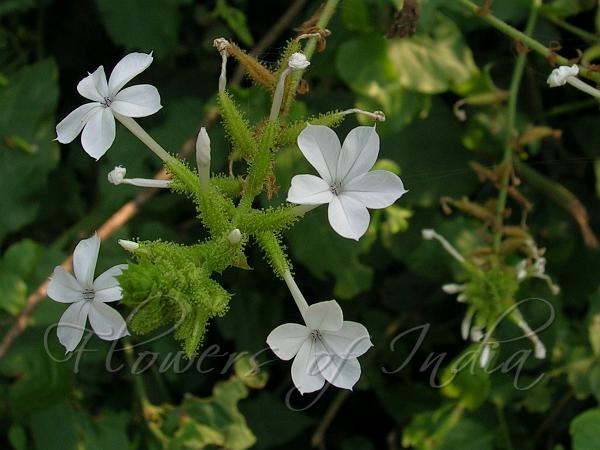|
| Chitrak |
|

|

| File size | 269952 |
| Original date | 9/30/06 3:13 PM |
| Resolution | 2048 x 1536 |
| Flash | Flash did not fire, auto |
| Focal length | 8.0mm |
| Exposure time | 1/155s |
| Aperture | 5.5 |
| Focus Distance | |
| Metering Mode | Partial |
| Camera make | NIKON |
| Camera model | E3700 |
| Sensor type |
|
|
|
Photo: Tabish |
Botanical name: Plumbago zeylanica Family: Plumbaginaceae (Plumbago family)
Chitrak is a herb that grows wild in India and has been used by rural and
tribal people for hundreds of years as a traditional system of medicine.
Chitrak is native to SE Asia. It is a much branched, evergreen shrub that
reaches about 6 feet in nature. Dark green leaves are ovate to 6 inches
long by half as wide. They are fast growing plants, but their size is
easily controlled by pot size and pruning. The flowers are white in showy
dense racemes and will flower all year long. Individual flowers are up to ½
inch (a bit more than 1 cm) across. Chitrak needs full sun to partial shade
with intermediate to warm temperatures. After flowering, the plants should
be cut back to keep them growing vigorously. The fruits are like a small
cocklebur with glue on the soft spines and they will stick to anything. The
root and root bark and seeds are used medicinally as a stimulant, caustic,
digestion, antiseptic, anti-parasitic. Chitrak is propagated by cuttings,
division of older plants or by seed.
Medicinal uses: Chitrak is used in treating intestinal troubles,
dysentery, leucoderma, inflammation, piles, bronchitis, itching, diseases
of the liver, and consumption. The leaves of this herb work well for
treating laryngitis, rheumatism, diseases of the spleen, ring worm,
scabies, and it acts as an aphrodisiac. A tincture of the root bark is used
as an anti-periodic. Chitrak root helps improve digestion and it stimulates
the appetite. Chitrak root is also an acro-narcotic poison that can cause
an abortion.
Chitrak is used in treating intestinal troubles,
dysentery, leucoderma, inflammation, piles, bronchitis, itching, diseases
of the liver, and consumption. The leaves of this herb work well for
treating laryngitis, rheumatism, diseases of the spleen, ring worm,
scabies, and it acts as an aphrodisiac. A tincture of the root bark is used
as an anti-periodic. Chitrak root helps improve digestion and it stimulates
the appetite. Chitrak root is also an acro-narcotic poison that can cause
an abortion.
Medicinal uses:
 Chitrak is used in treating intestinal troubles,
dysentery, leucoderma, inflammation, piles, bronchitis, itching, diseases
of the liver, and consumption. The leaves of this herb work well for
treating laryngitis, rheumatism, diseases of the spleen, ring worm,
scabies, and it acts as an aphrodisiac. A tincture of the root bark is used
as an anti-periodic. Chitrak root helps improve digestion and it stimulates
the appetite. Chitrak root is also an acro-narcotic poison that can cause
an abortion.
Chitrak is used in treating intestinal troubles,
dysentery, leucoderma, inflammation, piles, bronchitis, itching, diseases
of the liver, and consumption. The leaves of this herb work well for
treating laryngitis, rheumatism, diseases of the spleen, ring worm,
scabies, and it acts as an aphrodisiac. A tincture of the root bark is used
as an anti-periodic. Chitrak root helps improve digestion and it stimulates
the appetite. Chitrak root is also an acro-narcotic poison that can cause
an abortion.| Identification credit: Navendu Pagé, Vaibhav | Photographed in Garden of Five Senses, Delhi. |
• Is this flower misidentified? If yes,